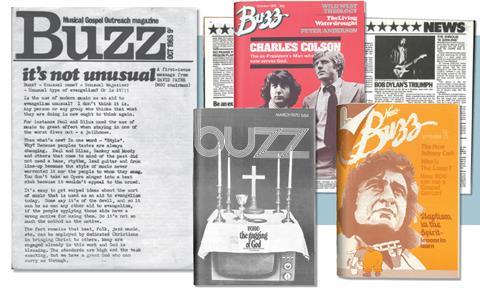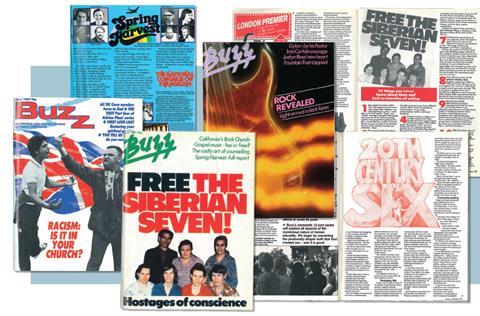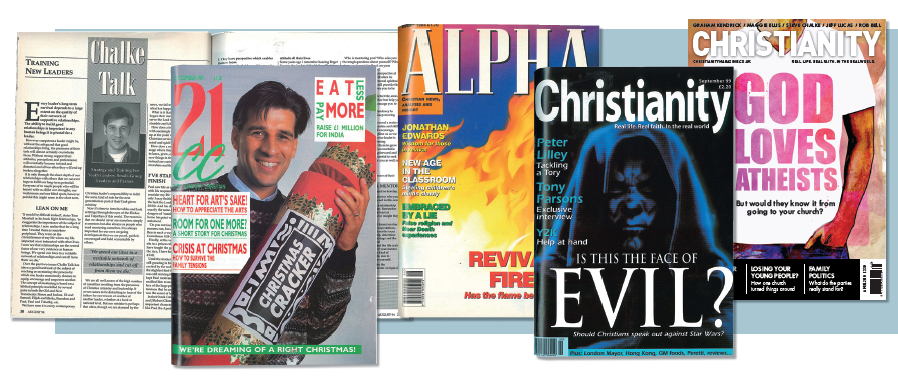How do you summarise half a century of journalism, spanning 600 editions of a publication that has had at least five different names? As Premier Christianity turns 50 this month, Justin Brierley and Sam Hailes have a go below and here.

Any history of Premier Christianity must first begin with the story of Buzz magazine, whose life spanned almost half of the 50 years we celebrate in this edition of the magazine.
The first copy of Buzz was produced in October 1965 as a newsletter for the recently formed Gospel Music Outreach, an organisation set up to resource the new wave of Christian beat bands playing in the popular church coffee bar scene. It consisted of a few folded sheets of foolscap paper, printed in black and white and collated by the enthusiastic volunteers of a church youth group. Yet these humble origins were revolutionary in their own way.
The ‘baby boom’ of the 40s had resulted in the 60s becoming the first decade in which youth culture was central. The Beatles and Rolling Stones spoke for a generation rebelling against the buttoned-down formalism that the evangelical churches were still wedded to. Buzz (named after the hum of the amplified speakers used by the pop groups) was a breath of fresh air compared to the ‘dull and denominational’ existing Christian publications, according to founding editor Peter Meadows.

‘It was fresh and new. It didn’t set out to be rebellious, it was just a new culture. Over the following five years or more, people just grabbed it avidly. There was no Internet. If you wanted information about what was happening on the youth scene through music, you had to have it.’
The early years were a hand-to-mouth affair. ‘[We worked] weekends, evenings and often through the night,’ recalls Meadows.
A cheap and more versatile form of photographic printing allowed the magazine to be produced on a tight budget. The style was plain-speaking, irreverent and fun, produced in a 25-shillings-a-week office space which also housed an eagle-shaped lectern (christened Archie; he became the mascot for the magazine’s gossip column).
The magazine continued to grow in readership, receiving a boost to its circulation when it incorporated Vistas, the magazine of British Youth for Christ, in the early 70s. The title also weathered a financial storm when the price shot up to 20p as the magazine began to include coloured printing.
By the late 70s, Buzz had outgrown its youth focus and was covering a wide range of church and social issues. Film, arts, science, sexuality, sports, and contemporary culture (especially music) were all explored. Coverage of Bob Dylan’s spiritual journey, and the 1970s rock scene (complete with flares and big hair) gave way to articles examining the rise of punk, football hooliganism and the spiritual journey of U2 in the 1980s. Steve Goddard, editor from 1980–87, also wrote a groundbreaking (and controversial) series entitled ‘20th Century Sex’.
Circulation peaked at over 30,000, with many more readers besides.
Significant initiatives included the birth of the Spring Harvest conference in partnership with Youth for Christ, and a campaign to ‘Free the Siberian Seven’, which received national coverage. Marches, petitions and lobbying of the Soviet government eventually saw 27 Soviet Christians (and a dog) safely released from the American embassy in Moscow.

In 1987, the magazine was rebranded as 21st Century Christian. Consciously aiming itself at ‘modern’ Christians, the title experienced something of an identity crisis, with safer editorial choices and less-than inspiring cover designs (compared to the psychedelic creativity of the 1970s). An ill-considered ‘Christian Yuppies’ column even earned the magazine the nickname ‘The Christian Yuppie’ by its critics.
Before long another rebrand took place, following a merger with the leadership journal Today in 1990. Alpha (no relation to the evangelistic course) aimed to reclaim some of the spirit of Buzz as well as appealing to Christian leaders. Steve Chalke, who was enjoying regular TV exposure as a young Baptist minister, became a regular contributor, while an equally youthful-looking John Buckeridge produced a regular section for youth workers, which turned into the sister magazine we know as Premier Youthwork today.
The charismatic scene of the early 90s was also covered in depth as the Toronto Blessing swept churches across the UK, including London’s HTB, accompanied with unusual manifestations of laughter and falling over.
‘There was a lot of grown-up thinking as well as the excess,’ says Dave Roberts, editor of Alpha and a charismatic himself. ‘I was a church leader so the kind of things we were writing about was stuff concerning me week in week out.’
By 1996 the magazine had adopted the title Christianity and would keep it through subsequent variations as Christianity & Renewal (after merging with Renewal magazine in 2001) and as Premier Christianity today.
Throughout the late 90s and 2000s, the magazine aimed to keep its finger pressed firmly to the beating pulse of culture. Celebrities such as the Spice Girls adorned front covers, while interviews with famous personalities such as Eamonn Holmes were secured by Steve Chalke. The magazine was capable of creating its own headlines too. In 2003, editor John Buckeridge commissioned several advertising agencies to create posters to re-sell the Church, an initiative which was widely featured on national press and TV.
However, it was Chalke himself who provided some of the headlines in the last ten years, as his views on penal atonement and homosexuality led to calls from some church leaders to have him removed from the Evangelical Alliance. The controversies were covered at length, and issues around homosexuality and the Church continue to dominate the news agenda to the present day.
Alongside controversy in the pages, the Christian press industry was undergoing its own drama. Changes in reading habits, denominational decline and the increasing prevalence of the Internet had sent circulation figures tumbling, seeing some long-standing publications, such as The Baptist Times, cease to exist in print.
Yet, despite predictions of the death of print, Premier Christianity has seen its circulation grow in the past few years. The Premier media family that we’ve been part of since 1999 (Premier Christian Radio having been founded by Peter Meadows in 1995) has provided a platform to introduce new readers to the magazine. And a recent overhaul of a formerly creaky website now sees thousands introduced to the magazine through online articles, blogs and news features.
This magazine was sparked by a creative vision to see the UK impacted for Christ by connecting ordinary believers with culture. In 50 years the hairstyles, pop music and rainbow-strapped guitars may have changed, but the vision remains the same. We thank God for the faithful work of those past and present who have kept that vision alight. And we look forward with confidence to what the future may hold in the next 50 years.








































1 Reader's comment